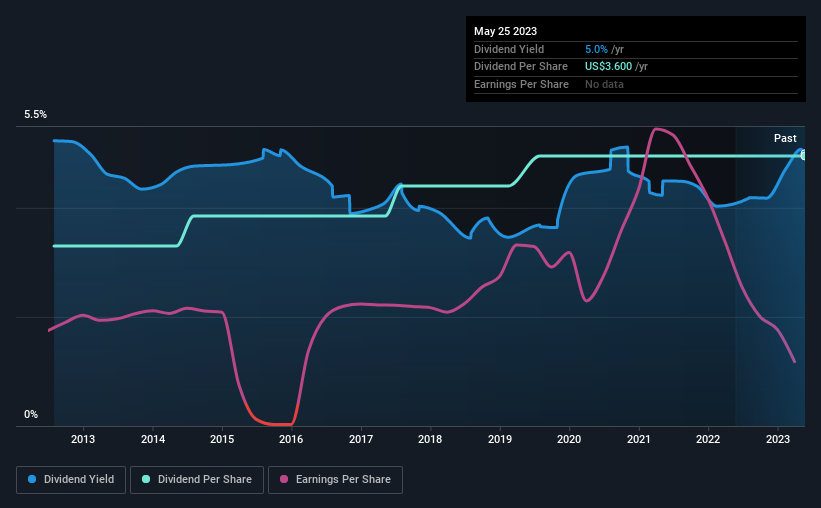Here's Why We're Wary Of Buying Safety Insurance Group's (NASDAQ:SAFT) For Its Upcoming Dividend
Regular readers will know that we love our dividends at Simply Wall St, which is why it's exciting to see Safety Insurance Group, Inc. (NASDAQ:SAFT) is about to trade ex-dividend in the next 4 days. The ex-dividend date is one business day before a company's record date, which is the date on which the company determines which shareholders are entitled to receive a dividend. The ex-dividend date is an important date to be aware of as any purchase of the stock made on or after this date might mean a late settlement that doesn't show on the record date. Therefore, if you purchase Safety Insurance Group's shares on or after the 31st of May, you won't be eligible to receive the dividend, when it is paid on the 15th of June.
The company's next dividend payment will be US$0.90 per share, and in the last 12 months, the company paid a total of US$3.60 per share. Last year's total dividend payments show that Safety Insurance Group has a trailing yield of 5.0% on the current share price of $72.13. If you buy this business for its dividend, you should have an idea of whether Safety Insurance Group's dividend is reliable and sustainable. So we need to investigate whether Safety Insurance Group can afford its dividend, and if the dividend could grow.
Check out our latest analysis for Safety Insurance Group
Dividends are usually paid out of company profits, so if a company pays out more than it earned then its dividend is usually at greater risk of being cut. An unusually high payout ratio of 201% of its profit suggests something is happening other than the usual distribution of profits to shareholders.
When a company pays out a dividend that is not well covered by profits, the dividend is generally seen as more vulnerable to being cut.
Click here to see how much of its profit Safety Insurance Group paid out over the last 12 months.
Have Earnings And Dividends Been Growing?
Businesses with shrinking earnings are tricky from a dividend perspective. If business enters a downturn and the dividend is cut, the company could see its value fall precipitously. Readers will understand then, why we're concerned to see Safety Insurance Group's earnings per share have dropped 16% a year over the past five years. Such a sharp decline casts doubt on the future sustainability of the dividend.
Another key way to measure a company's dividend prospects is by measuring its historical rate of dividend growth. Safety Insurance Group has delivered an average of 4.1% per year annual increase in its dividend, based on the past 10 years of dividend payments. The only way to pay higher dividends when earnings are shrinking is either to pay out a larger percentage of profits, spend cash from the balance sheet, or borrow the money. Safety Insurance Group is already paying out a high percentage of its income, so without earnings growth, we're doubtful of whether this dividend will grow much in the future.
The Bottom Line
Has Safety Insurance Group got what it takes to maintain its dividend payments? Not only are earnings per share shrinking, but Safety Insurance Group is paying out a disconcertingly high percentage of its profit as dividends. Generally we think dividend investors should avoid businesses in this situation, as high payout ratios and declining earnings can lead to the dividend being cut. Safety Insurance Group doesn't appear to have a lot going for it, and we're not inclined to take a risk on owning it for the dividend.
With that in mind though, if the poor dividend characteristics of Safety Insurance Group don't faze you, it's worth being mindful of the risks involved with this business. Be aware that Safety Insurance Group is showing 2 warning signs in our investment analysis, and 1 of those can't be ignored...
If you're in the market for strong dividend payers, we recommend checking our selection of top dividend stocks.
Have feedback on this article? Concerned about the content? Get in touch with us directly. Alternatively, email editorial-team (at) simplywallst.com.
This article by Simply Wall St is general in nature. We provide commentary based on historical data and analyst forecasts only using an unbiased methodology and our articles are not intended to be financial advice. It does not constitute a recommendation to buy or sell any stock, and does not take account of your objectives, or your financial situation. We aim to bring you long-term focused analysis driven by fundamental data. Note that our analysis may not factor in the latest price-sensitive company announcements or qualitative material. Simply Wall St has no position in any stocks mentioned.
Join A Paid User Research Session
You’ll receive a US$30 Amazon Gift card for 1 hour of your time while helping us build better investing tools for the individual investors like yourself. Sign up here

